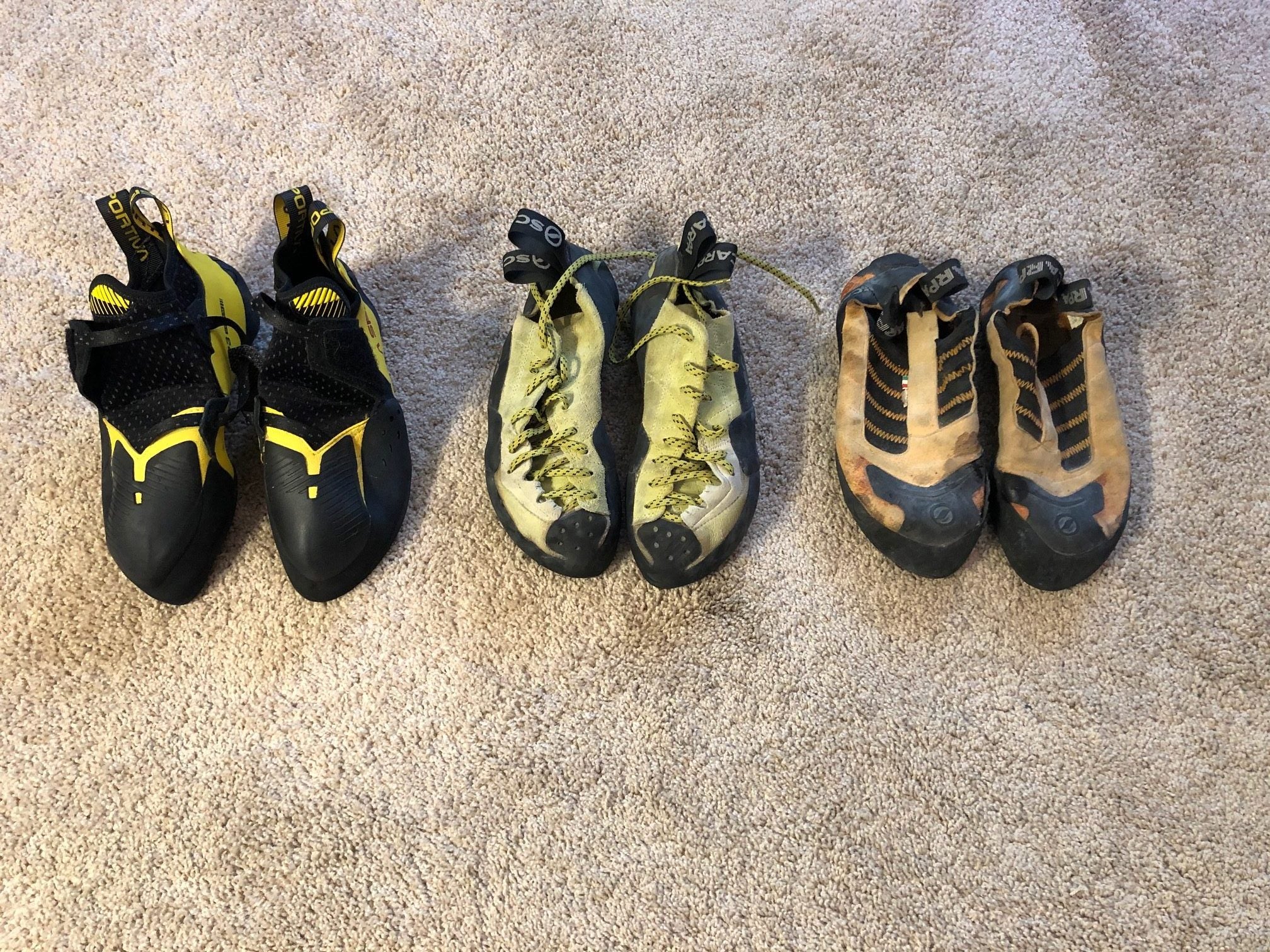When Should You Resole Your Climbing Shoes?

Three pairs of shoes in various stages of "life." From left, a brand-new pair of La Sportiva Solution Comps, a mildly used pair of Scarpa Magos (still with their original sole), and a well-used pair of Scarpa Instinct S slippers on their third or fourth resole—and about ready to retire (throw away) for good. (Photo: Matt Samet)
We demand more from our climbing shoes than from any other piece of gear. Rock shoes are safety gear—good footwork coupled with faith in reliable shoes is what keeps us attached to the rock. Protect yourself—and climb better—by caring for your climbing shoes. One big part of that equation is understanding when you should resole your climbing shoes.
Only a few climbers (most pro) retire shoes after they burn through the factory sole. The rest of us have our shoes resoled, which at $62 to $92 a pop, is cheaper than buying a new pair. Refurbishing your current pair also happens to be more environmentally friendly than tossing them and springing for new shoes. There are, however, a few things to know both about resoling and extending your shoe lifespan to ensure they remain good candidates for repeated resoles.
So we turned to Rock & Resole in Boulder, CO, which has been resoling climbing shoes since 1989. We asked Rock & Resole founder Eric Pauwels for the tips he’s gleaned from resoling thousands of pairs. Here are some FAQs to help you stay on top of your soles.
When is it time to resole climbing shoes?
Pauwels says that 90 percent of sole wear takes place in the big-toe area. Therefore, that should be where you evaluate rubber thickness when deciding to resole. “Keep in mind that you start with a four-millimeter sole there, and it will gradually decrease to the point where it’s paper thin,” says Pauwels. “At that point you want to resole.” Climbers often make the mistake of looking at general sole condition or the outside of the shoe, but the big toe (our foot’s power point) invariably wears thin first—unless you’re a serial heel hooker.
Our Picks
Do I need toe caps?
Toe caps are patches of sticky rubber used to repair holes in the rand. A thinner (two-millimeter) band of rubber wraps laterally around a shoe’s upper. Your resoler might replace the full rand or just cut away a small crescent-shaped swatch and glue on new rand rubber. If your rand has a visible hole in it, you need a toe cap, but you might also need a toe cap absent a hole. That’s because a rand can develop weaknesses around the toe box, depending on wear patterns. (Maybe you are a “toe dragger,” or do lots of gym climbing involving sharp little jibs.)
How do I inspect a rand that doesn’t have visible holes?
- Start by the pinkie toe, which generally has the least amount of rand wear. Pinch the rand with your thumb, working toward the big toe.
- With the perspective of a full-thickness rand, inspect for areas of reduced resistance. They can be focused like a pinhead or as large as a pencil eraser.
- Pay particular attention to rand wear on shoes that have stiff (plastic) midsoles. These tend to spread your feet outward and create pressure against the outside of the shoe.
- Point out any trouble spots to your resoler, and ask about a toe cap. Note that getting a toe cap will also mean getting a new half-sole. You have to remove the old sole to put on the toe cap because rand rubber wraps a quarter inch around beneath the outsole. In a perfect world, you’ll time a toe cap with a new sole.
What if I’ve punched through the suede or synthetic upper?
Are your shoes kaput? Not necessarily. Cobblers can layer a netting or mesh fabric to repair these sorts of holes and firm up the upper, including in high-impact areas like the toe box. Even if you’ve punched a hole through your rand and upper, your shoes might be salvageable. A cobbler can mend smaller holes with a leather patch and then overlay new rubber.
How many times can I resole my shoes?
Pauwels says that a looked-after pair of performance shoes can typically be resoled three or four times. How do you know your pair is well “looked after?”
- No rotting or deterioration in the footbed and midsole
- Uppers and closure system still intact
After that, the shoes generally won’t hold their shape. “If you’re climbing moderate slabs up the Flatirons, you might get a dozen,” says Pauwels. “But if you’re crack climbing, you might get two.”
What do I do with old shoes I can’t use anymore?
If your shoes are so beat up that you can’t use them, chances are no one else wants them either. Pauwels says it’s best to just throw them away—there is limited demand for recycled rubber, and the rubber from climbing shoes represents such a small fraction of this that the shoes usually end up in the landfill anyway.
That said, you can recycle your shoes through the GotSneakers shoe recycling program, or order a Trashie Bag and throw your shoes in with any old clothes you no longer want.
© 2013. Reprinted with permission of the publisher from Crag Survival Handbook by Matt Samet, Mountaineers Books, Seattle.



